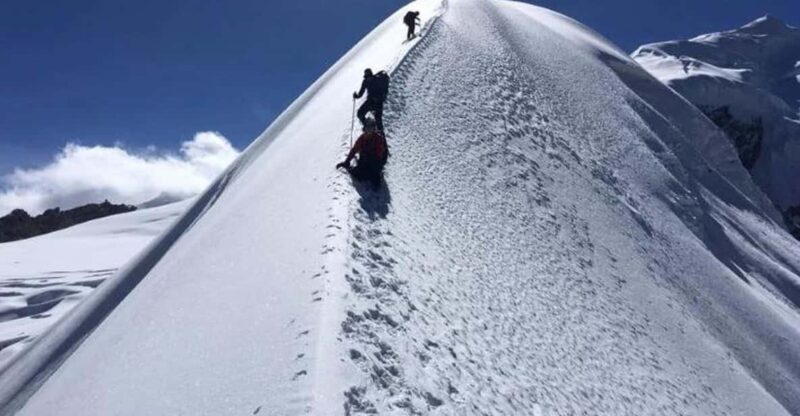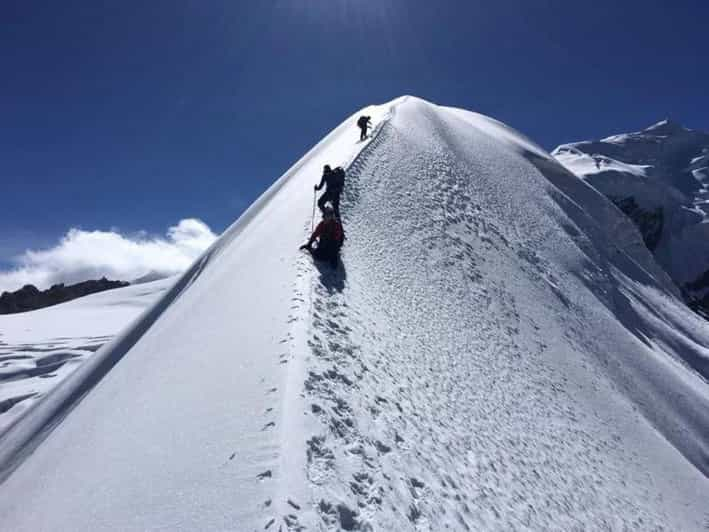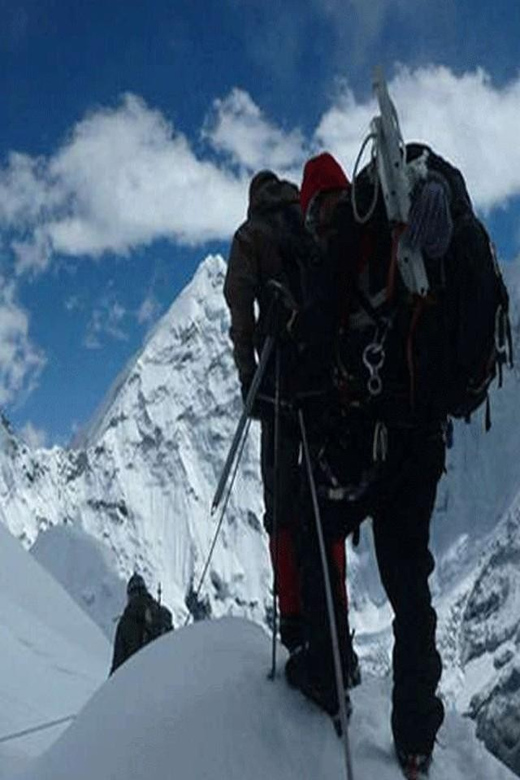Chulu West Peak’s climbing expedition offers an unparalleled opportunity for intrepid adventurers. Standing tall at 6,419 meters, this formidable Himalayan summit demands both physical prowess and technical mountaineering skills. Trekkers will embark on a journey through picturesque villages, acclimatizing at progressively higher camps before attempting the peak’s awe-inspiring summit. Supported by experienced Sherpa guides, climbers can fully enjoy the breathtaking beauty of the Annapurna region. However, the challenges posed by altitude and the sheer technical difficulty of the climb should not be underestimated.
Key Points

- Chulu West (6,419m) offers a challenging yet technically straightforward snow ascent for trekkers and climbers in the Annapurna region.
- Proper acclimatization, mountaineering skills, and Sherpa guide support are essential for a successful and safe summit attempt.
- The 15-day expedition involves a scenic trek through Dharapani, Chame, Pisang, and Manang, with acclimatization days along the way.
- Climbers ascend through Letdar, Chulu West Base Camp, High Camp, and Camp I at 5,530m before attempting the final summit.
- Participants must bring personal mountaineering gear like boots, crampons, harness, and ice axe, while the organizers provide group camping and climbing equipment.
Peak Overview
Chulu West (6,419m) presents an exciting challenge for experienced trekkers and amateur climbers.
Technically straightforward compared to Chulu East, it requires stamina and strength for the snow ascent. The location in the Annapurnas offers stunning views of the Annapurna range and borders of Tibet and China.
Though not as technically demanding as its eastern counterpart, Chulu West still demands considerable mountaineering skill and experience. Trekkers must be prepared for the rigors of high-altitude climbing, including managing fatigue, breathing difficulties, and the risk of altitude sickness.
With proper acclimatization and support, however, Chulu West can be a rewarding and unforgettable mountaineering experience.
You can also read our reviews of more tours and experiences in Muktinath.
Itinerary at a Glance

The 15-day adventure begins with a scenic drive to Dharapani, situated at an elevation of 1,946 meters.
The trek then progresses to Chame, Pisang, and Manang, where an acclimatization day is scheduled. Climbers will then ascend to Letdar, Chulu West Base Camp, and High Camp before attempting to reach Camp I at 5,530 meters.
The summit of Chulu West (6,419 m) is the ultimate goal, followed by the descent via the Thorung La pass (5,416 m).
Throughout the expedition, trekkers will be supported by an experienced Sherpa guide and staff, as well as porters to carry the necessary equipment.
Acclimatization and Climbing

Proper acclimatization is crucial for enduring the challenges of the expedition. Climbers will spend three nights at the Chulu camps – Base Camp, High Camp, and Camp I – to allow their bodies to adjust to the high altitude.
During this time, they’ll practice essential climbing techniques before attempting the summit. This gradual ascent helps build endurance and reduces the risks of altitude sickness.
The route features a steady climb, with the final push to the 6,419-meter Chulu West Peak requiring stamina and strength to traverse the snowy slopes.
Careful planning of the acclimatization process ensures climbers are well-prepared for the demanding summit bid.
Gear and Equipment
Climbers must bring their own personal mountaineering gear for the Chulu West Peak expedition. This includes technical equipment like:
- Mountaineering boots with sturdy soles and ankle support
- Crampons for traction on snow and ice
- Harness, carabiners, and other climbing hardware
- Ice axe for self-arrest and stability on steep slopes
The expedition organizers will provide all necessary group camping and climbing equipment, such as tents, stoves, ropes, and safety gear.
However, each participant is responsible for ensuring they’ve the proper personal items to safely navigate the technical terrain and harsh high-altitude environment of Chulu West.
More Great Tours NearbyCosts and Inclusions
The Chulu West Peak climbing expedition package includes a range of essential services and equipment to support trekkers throughout the journey. Transportation, accommodation, meals, guides, and porters are all provided. However, personal expenses, climbing gear, travel insurance, and visa fees are excluded.
| Inclusions | Exclusions |
|---|---|
| Airport transfers | Personal expenses |
| 5 nights camping | Mountaineering gear |
| Meals during trekking | Travel insurance |
| Experienced Sherpa guide | Nepal visa fee |
Trekkers should budget an additional $10-$14 per meal for lunch and dinner in cities. With the right planning and preparation, the Chulu West Peak climbing expedition offers an unforgettable Himalayan adventure.
- From Pokhara: 5 Day Private Guided Upper Mustang Jeep Tour
- 8 Day Kathmandu,Pokhara, Muktinath (Lower Mustang) Jeep Tour
- Kathmandu or Pokhara Budget: 13 Day Annapurna Circuit Trek
- From Kathmandu: 18 Days Upper Mustang Trek
- Nepal Odyssey: A Spiritual Journey – Kathmandu to Muktinath
- Pokhara: 4 Day Lower Mustang,Dhumba Lake,Muktinath Jeep Tour
Logistics and Transportation
Getting to the starting point of the Chulu West Peak climbing expedition involves a well-planned transportation arrangement. The trip begins with airport transfers from Pokhara or Kathmandu to Dharapani, the starting point of the trek, in a private vehicle.
Along the way, the group will pass through scenic landscapes and charming villages. The transportation includes:
- Airport transfers in a private vehicle.
- Ground transportation during the trek in a private vehicle or jeep.
- Porters to carry the gear and supplies.
- Access to local transportation as needed during the expedition.
These logistical details ensure a smooth and comfortable journey to the base of Chulu West Peak.
Safety and Experience
With safety as the top priority, experienced mountaineering guides lead the way throughout the Chulu West Peak climbing expedition. Their expertise ensures proper acclimatization and technical climbing techniques are mastered at each camp before the summit push. Climbers receive thorough pre-trip training and are outfitted with high-quality gear to handle the challenging conditions. Should any issues arise, the guides are equipped to provide immediate first aid and implement emergency evacuation protocols if needed. The team’s commitment to safety allows adventurers to focus on the exhilaration of reaching Chulu West’s lofty summit.
| Level of Experience | Technical Difficulty | Safety Precautions |
|---|---|---|
| Beginner | Moderate | Close Supervision |
| Intermediate | Challenging | Ropes and Harnesses |
| Advanced | Demanding | Medical Preparedness |
| Expert | Extreme | Evacuation Protocols |
Preparing for the Expedition
Preparing for the Chulu West Peak climbing expedition requires thorough planning and preparation. Trekkers must ensure they’ve the proper equipment, including mountaineering boots, crampons, harness, and ice axe.
Acclimatization is crucial, with several nights spent at progressively higher camps for the body to adjust. Climbing techniques should be practiced at the base camp and high camp before the summit attempt.
Frequently Asked Questions
What Permits Are Required for the Chulu West Peak Climbing?
For Chulu West Peak climbing, trekkers need a Trekking Permit, Annapurna Conservation Area Permit, and Climbing Permit. These permits ensure compliance with regulations and provide access to the protected mountain region.
Can I Rent Climbing Gear During the Expedition?
Yes, climbers can rent essential climbing gear like mountaineering boots, crampons, harnesses, and ice axes from the expedition organizer. This gear rental service is typically included in the overall package price for the Chulu West Peak climbing expedition.
Is There Medical Assistance Available in Case of Emergencies?
There is medical assistance available during the expedition. The tour company provides a team of experienced Sherpas and a guide who are qualified to handle emergencies and provide first-aid on the mountain.
What Is the Best Time of Year to Attempt the Chulu West Climb?
The best time to attempt the Chulu West climb is during the spring (March to May) or autumn (September to November) seasons. These periods offer the most stable weather conditions and ideal snow cover for the ascent.
Can I Extend the Expedition to Include Other Peaks in the Annapurna Region?
Yes, the Chulu West expedition can be extended to include other peaks in the Annapurna region. Experienced climbers may wish to tackle nearby summits like Chulu East or Gangapurna for a more challenging and comprehensive Himalayan climbing experience.
Recap
Chulu West Peak offers an exhilarating challenge for experienced climbers. The trek through charming villages and the thrilling summit attempt amidst the breathtaking Himalayan scenery make this expedition a true adventure. With proper acclimatization, reliable equipment, and expert Sherpa guides, climbers can safely and successfully reach the 6,419-meter peak, seeing the stunning natural beauty of the region.
You can check availability for your dates here:More Tour Reviews in Muktinath
Not for you? Here's more things to do in Muktinath we have recnetly reviewed
- 3 Best Guided Tours In Muktinath
- 8 Best 3 Day Tours In Muktinath
- 5 Best 2 Day Tours In Muktinath
- 5 Best 4 Day Tours In Muktinath
- 25 Best Tours In Muktinath
- 2 Best Bike Tours In Muktinath
- 5 Best Hiking And Trekking Tours In Muktinath
- 5 Best Hiking And Trekking Tours In Muktinath
- From Pokhara: Jomsom, Muktinath, and Tatopani 3-Day Tour
- From Pokhara: 5 Day Lower Mustang & Poon Hill 4WD Jeep Tour
- 15-Day Muktinath Temple Trek
- Jomsom Muktinath Family Trek
